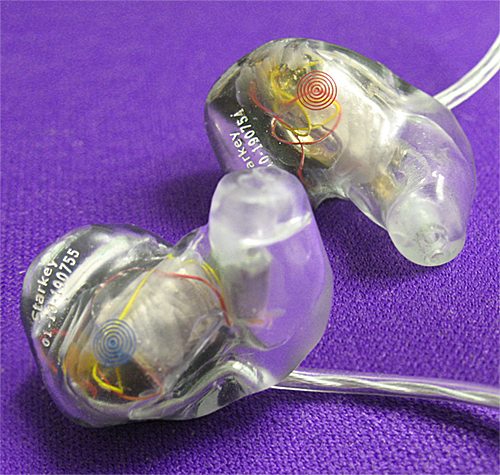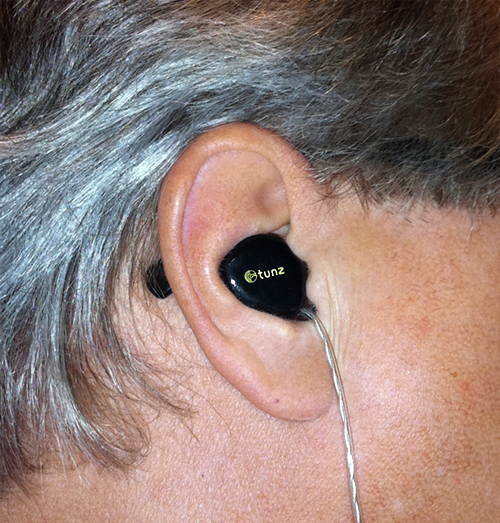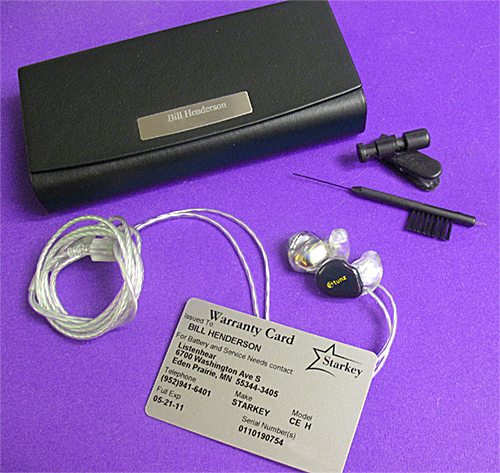
While some earphones/headphones available for the iPhone/iPod/iPad are great, most fall into the pretty good category. But all of them are light years better than the earbuds that come standard with your device. The difference is that noticeable. This is not a review for you who are still using earbuds, unless you KNOW how awful they are. This review is for you who already have a decent pair of earphones and want to move on to a higher level. And one way to do that is to go custom, like the Tunz Duo in-ear monitors from Starkey Labs.
If you are unaware of what exactly custom means in earphones, think about the last time you saw a performer live or on TV. Today, the majority of musicians have what looks like bad hearing aids in both ears. Those aren’t hearing aids and they are most definitely not bad. They are earphones that are custom molded to their ears.
See, ears are like fingerprints. No two are alike. The advantages to acquiring custom earphones are obvious: They will fit you, and no one else… perfectly. The not-so-obvious advantages are increased noise isolation and better bass response. And your friends can’t borrow them (they won’t fit)!

First lets deal with the fit. With customs, as you insert the earphones, they will literally “snap” into place. It can feel really weird at first. But they will stay in place. No more adjusting or fiddling to get a good seal. And know this, no seal means no bass. Then, there is the almost total isolation from your surroundings. Technically, it’s about 24-26 dB of isolation – which is a LOT. You can be riding the noisiest subway and still be lost in your own world. The fit is that good.
The main disadvantage of custom earphones is the price. They are not for the faint of heart. Custom in-ear monitors can go well over $1000. Most fall into the $500-$1000 range. But there is good news for those who are interested in going custom, but will not (or cannot) spend close to that amount, no matter how good they sound.
Starkey Labs in Minnesota have released a brand of in-ear monitors called Tunz. I am concentrating on the consumer dual armature model, called the Tunz Duo In-Ear monitor. At $250 (not including the ear impression cost), the Duos are one of the least expensive dual armature custom monitors on the market.
You begin by getting an open mouth impression (or mold) made of your inner ear by an audiologist (appx. $40-75). It’s a process that takes about 15 minutes. Once the impressions are made, they are then mailed to Starkey Labs for construction. In about 2 weeks, your custom earphones arrive (you won’t find these earphones in a store).
Inside the box are your earphones, a shirt clip, cleaning tool, and a hard case with the customers name engraved on it.
It may take some practice to insert the earphones, but they will literally snap into place if done correctly. Once in, they stay in.
Interestingly, these customs cost about the same as most good quality universal-sized duos. So you have the added benefit of a custom fit for the same price (minus the impressions cost). Not a bad deal.
So how does the sound compare with other duo or triple armature earphones? I’m happy to say, pretty well, thank you. The Duos are equipped with one bass and one treble armature. I’ll admit that they are not quite as accurate as some triple armature (bass, treble, midrange) earphones I own, but the Duos tackled much of what I threw at them with a surprising warmth. Many armature-based earphones can be overly bright. These aren’t.
I wanted to see how the Duos handled bass, since this is where most dual (and more) armature customs really shine. I began with the Robert Plant and Alison Krauss album, “Raising Sand.” For an album of well-recorded Americana music, this really kicks bass. I’m sure the producer, T-Bone Burnett had a lot to do with this.
I can’t listen to “Raising Sand” in my car, because the speakers just can’t handle that much bass. But hearing these wonderful songs through the Tunz Duos is ear-opening. Believe it or not, this rediscovered bottom end brings out the highs in strange ways. The jangly guitars and Krauss’ high whine in “Polly Come Home” gets hung out to dry on lesser speakers. But with the Duos, the highs suddenly have balance with the bass and static drum pounding. Finally, the song sounds complete.
Speaking of Robert Plant, his song “Big Log” from “Nine Lives” features a mid-range percussive repeat that counters nicely with the string arrangements. However the Duos do bring out a certain sibilant quality to Plant’s vocals. This song is proof that with the Duos, you are much better off with higher resolution files, which is usually necessary with better earphones.
If you want a kick to the teeth, crank up “Thunderstruck” from AC-DC. Chris Slade’s bass drum attack vibrates the brain… in a good way. This song must be played loud to be fully appreciated. But like before, have a high resolution version available.

Moving in a totally different direction, but still following the bass route, is Paul Simon’s “Diamonds On the Soles of Her Shoes” from “Graceland”. The backing vocals of the South African group, Ladysmith Black Mambazo, provide a gutteral low undercurrent that accentuates Simon’s vocal woo-hoo-ing throughout the song. And when the bass drum kick comes in at the beginning of “Boy In the Bubble”, you jump in surprise even though you fully expect it.
“Long Haired Lady” from Paul McCartney’s “Ram” isn’t what you could call an audiophile recording but Paul’s multi-instrumental talents are in full bloom here. The intimacy is immediate with no drag in the vocals. The crescendo ending is a fun, delightful mess coming from a wall-of-sound approach.
Another example of how unforgiving the Duos can be is The Byrds, “I’ll Feel A Whole Lot Better” from their Greatest Hits album. The highs in this great song will absolutely set your teeth on edge. Talk about something in need of remastering. It’s just awful.
The Philadelphia Orchestra’s version of Claude Debussy’s “Claire de lune” from the “Ocean’s Eleven” soundtrack is a beautiful wash of melancholic strings which the Duos allow to breath. The spaciousness of the piece is immediately apparent and that’s not easy with earphones. Open-backed headphones can provide a better soundstage, but then they’re not exactly portable, are they?
If you are still listening to those supplied (free) earbuds and think you are happy with the sound, please, oh please do yourself a favor and invest (at minimum) $60 and upgrade to earphones. A whole new world will open up to you. But be warned: Once you get a taste of that aural sweetness, you’re going to want more and better audio sugar… much like the Tunz Duos.
Updates
I still use the Starkey Labs Tunz Duo In-Ear Monitors. Since I review many earphones and headphones, most are not used on a regular basis. Not these. I now use them for music listening while I work around my 2-acre property in Florida. These custom made monitors are so comfortable, that I hardly feel them and they have held up wonderfully over the last 4 years. Plus, they block out so much noise that I can use anything motorized for hours with no worries. The Starkey Labs Tunz Duo In-Ear Monitors have probably saved my hearing. That’s high praise.
Source: The sample for this review was provided by Starkey Labs. Please visit their site for more info.
Apple iPad Air 2 16GB WiFi 2GB iOS 10 9.7in Tablet - Space Gray (Renewed)
CiBest Mini Projector, 2025 Upgraded Full HD 1080P Support Video Projector, Portable Small Movie Projector, Compatible with iOS/Android/Windows/TV Stick/Box/USB/HDMI
17% OffProduct Information
| Price: | $250 US |
| Manufacturer: | Starkey Labs |
| Requirements: |
|
| Pros: |
|
| Cons: |
|



Gadgeteer Comment Policy - Please read before commenting
Thank you for the review, Bill. While I’ve never used any Starkey Labs products, my life changed the day I got my Shure E3Cs. While they’re far from being pro in ear monitors, I suddenly realized why some people hate low bitrate MP3s.
I have since moved on to buy two headphone amps. Another big leap in quality. The Bithead (one of my reviews here) really helped especially in it’s capacity as a DAC and I won’t go back.
Lastly, I moved on to some Beyer Dynamic BT 880 open headphones. A totally different listening experience to my Shures and for totally different situations. I REALLY encourage everyone out there to listen to Bill’s advice and invest in some good headphones.
This is a good article for those who might think they’ve already got some reasonable earbuds: http://gizmodo.com/5617200/the-secret-scam-of-cheap-earbuds
sorry! silly typo there! Those were DT-880 headphones 🙂
Thanks Andrew, I’m glad you liked the review. I have the Grado 325is and love them.
Never knew Starkey made earphones,their hearing aids are well known.
As far as headphones go,the poster that loves his grados should seek out some starkey hearing aids if he thinks they sound good.
Parsavar,
As the poster who loves his Grado 325is headphones, I appreciate your comment. To each his own. 😉
Thanks for reading!
Bill, thanks for this review. I am a pro musician who wears hearing aids which are not useful for live performance. My audiologist wants to sell me these Starkey in ear monitors because that is what he deals. I cannot find any reviews that compare these monitors with say the Cleartune CTM-200’s or any other of the usual iem’s. Your thoughts?
Bill,
I am not a musician, so I can’t comment on listening to music vs. monitoring for stage. I will say that I am still using the Starkey earphones 3 years later. That’s saying something.
I have not heard the Cleartune models, so I’m not much help there.
I LOVE JHAUDIO’s earphones. Jerry Harvey practically invented the IEM industry. A lot of Pros use their products. Here’s their website:
http://www.jhaudio.com
If your audiologist deals with Starkey, I think you will be pleased, from a quality standpoint.
Bill H.
I’m a semi-professional drummer of 25+ years and during that time I really put my ears thru a lot of tough stuff- mind numbingly loud monitors and amps for hours at a time, not to mention being right over one of the loudest instruments on stage. I have used in-ears for the past 8 years or so and it has been a good thing. Jan 2016 I got my custom fitted Starkey Tunz in- ears and they have been amazing- if I had known the difference sooner, I would have got them years ago. First off, they fit great and cut out a lot of my live drum noise. Second, since the ambient noise is down, I can run my custom ear mix at a much lower volume- which reduces the fatigue on my ears and allows me to play longer amounts of time without abusing my eardrums. Third, the great fit and the separate bass armature increases the bass response in my mix, which is very important for a drummer. My advise, spend a little more and get an audiologist to make your molds- chances are, they are already familiar with Starkey for hearing aids. The Tunz ear pieces are laser engraved with your serial number and production date.
Thanks for the review, Bill!
I’m doing some research on these and found this review so I know it’s more than a few years later. In my research, I’ve found that some people really prefer the silicone based molds as opposed to the acrylic kind that these are. A buddy of mine says that for wearing for long periods of time, such as on long motorcycle trips, the acrylics become unbearable but the silicon ones (the ones from plugup.com) feel great. They only have 2 drivers in them and the new Starkey’s have 3. Since I’m an audio engineer and lean toward audio quality first, I opted for the 3-driver Starkey acrylics but I’m concerned about them growing uncomfortable over long periods of time. I’m curious… do you have a comfort problem with long-period use of these Starkey molds?
Jamie,
I have never reviewed silicone in-ear monitors, although I would love to someday. I have 4 pair of custom acrylic earphones and 3 are comfortable. The one that is not is a pair that just don’t fit properly. That’s the key. If they are fitted correctly, you can wear them for hours. The Starkey earphones reviewed here were the most comfortable I have. Unfortunately, the mini plug went bad and they don’t work anymore – the cord is not removable. These were single driver so they were smaller in my ear. Bottom line is how well the mold is made. Don’t settle for anything less than a PERFECT fit.